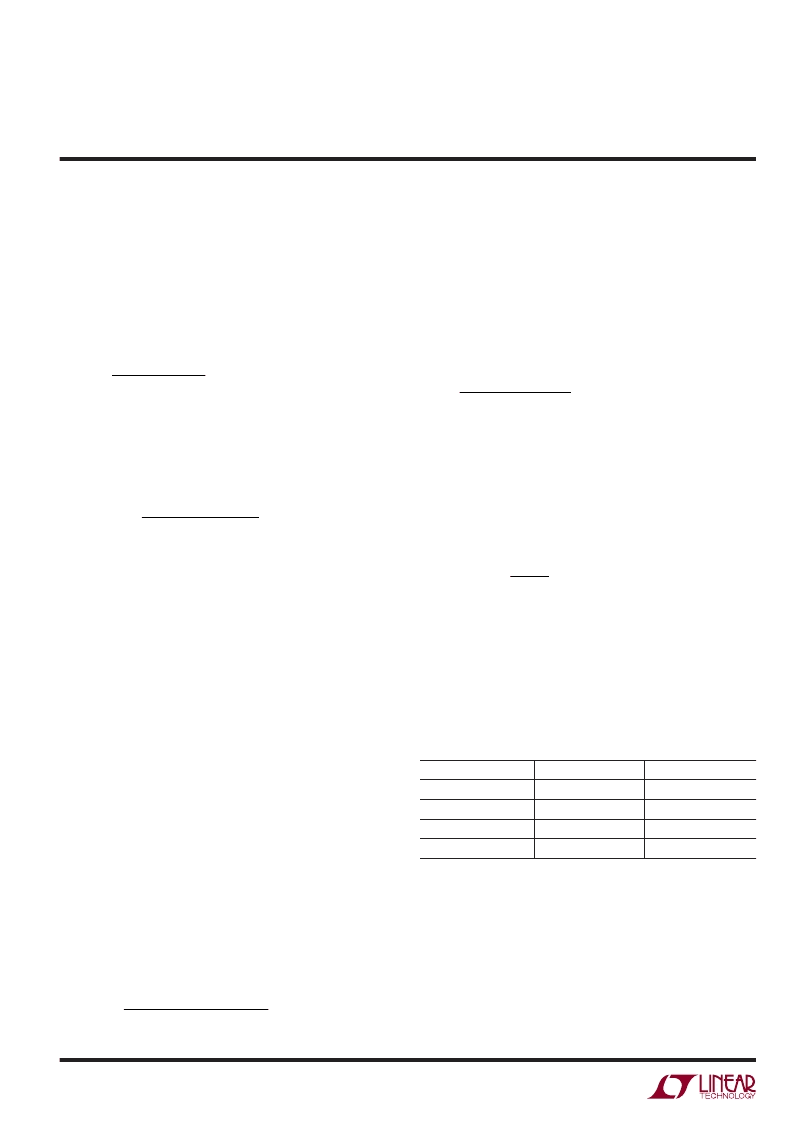- 您現(xiàn)在的位置:買賣IC網(wǎng) > PDF目錄377724 > LT3470ETS8 (Linear Integrated Systems) Micropower Buck Regulator with Integrated Boost and Catch Diodes PDF資料下載
參數(shù)資料
| 型號(hào): | LT3470ETS8 |
| 廠商: | Linear Integrated Systems |
| 英文描述: | Micropower Buck Regulator with Integrated Boost and Catch Diodes |
| 中文描述: | 微功耗降壓穩(wěn)壓器與集成升壓二極管和捕捉 |
| 文件頁數(shù): | 8/16頁 |
| 文件大?。?/td> | 205K |
| 代理商: | LT3470ETS8 |

8
LT3470
3470f
APPLICATIU
Input Voltage Range
The minimum input voltage required to generate a particu-
lar output voltage in an LT3470 application is limited by
either its 4V undervoltage lockout or by its maximum duty
cycle. The duty cycle is the fraction of time that the internal
switch is on and is determined by the input and output
voltages:
V
V
V
V
V
IN
SW
D
+
–
where V
D
is the forward voltage drop of the catch diode
(~0.6V) and V
SW
is the voltage drop of the internal switch
at maximum load (~0.4V). Given DC
MAX
= 0.90, this leads
to a minimum input voltage of:
W
U
U
DC
OUT
D
=
+
V
V
V
+
DC
V
V
IN MIN
(
OUT
D
MAX
D
SW
)
–
=
+
This analysis assumes the part has started up such that the
capacitor tied between the BOOST and SW pins is charged
to more than 2V. For proper start-up, the minimum input
voltage is limited by the boost circuit as detailed in the
section BOOST Pin Considerations.
The maximum input voltage is limited by the absolute
maximum V
IN
rating of 40V, provided an inductor of
sufficient value is used.
Inductor Selection
The switching action of the LT3470 during continuous
operation produces a square wave at the SW pin that
results in a triangle wave of current in the inductor. The
hysteretic mode control regulates the top and bottom
current limits (see Electrical Characteristics) such that the
average inductor current equals the load current. For safe
operation, it must be noted that the LT3470 cannot turn the
switch on for less than ~150ns. If the inductor is small and
the input voltage is high, the current through the switch
may exceed safe operating limit before the LT3470 is able
to turn off. To prevent this from happening, the following
equation provides a minimum inductor value:
L
V
t
I
MIN
IN MAX
(
MAX
=
)
ON-TIME(MIN)
where V
IN(MAX)
is the maximum input voltage for the
application, t
ON-TIME(MIN)
is ~150ns and I
MAX
is the maxi-
mum allowable increase in switch current during a mini-
mum switch on-time (150mA). While this equation provides
a safe inductor value, the resulting application circuit may
switch at too high a frequency to yield good efficiency. It
is advised that switching frequency be below 1.2MHz
during normal operation:
f
DC V
L
V
I
D
OUT
L
=
+
)
1–
where f is the switching frequency,
I
L
is the ripple current
in the inductor (~150mA), V
D
is the forward voltage drop
of the catch diode, and V
OUT
is the desired output voltage.
If the application circuit is intended to operate at high duty
cycles (V
IN
close to V
OUT
), it is important to look at the
calculated value of the switch off-time:
t
DC
f
OFF-TIME
=
1–
The calculated t
OFF-TIME
should be more than LT3470’s
minimum t
OFF-TIME
(See Electrical Characteristics), so the
application circuit is capable of delivering full rated output
current. If the full output current of 200mA is not required,
the calculated t
OFF-TIME
can be made less than minimum
t
OFF-TIME
possibly allowing the use of a smaller inductor.
See Table 1 for an inductor value selection guide.
Table 1. Recommended Inductors for Loads up to 200mA
V
OUT
V
IN
Up to 16V
2.5V
3.3V
5V
12V
V
IN
Up to 40V
33
μ
H
33
μ
H
33
μ
H
47
μ
H
10
μ
H
10
μ
H
15
μ
H
33
μ
H
Choose an inductor that is intended for power applica-
tions. Table 2 lists several manufacturers and inductor
series.
For robust output short-circuit protection at high V
IN
(up
to 40V) use at least a 33
μ
H inductor with a minimum
450mA saturation current. If short-circuit performance is
not required, inductors with I
SAT
of 300mA or more may
be used. It is important to note that inductor saturation
相關(guān)PDF資料 |
PDF描述 |
|---|---|
| LT3470ITS8 | Micropower Buck Regulator with Integrated Boost and Catch Diodes |
| LTBDM | Micropower Buck Regulator with Integrated Boost and Catch Diodes |
| LT3486 | Dual 1.3A White LED Step-Up Converters with Wide Dimming |
| LT3486EDHC | Dual 1.3A White LED Step-Up Converters with Wide Dimming |
| LT3486EFE | Dual 1.3A White LED Step-Up Converters with Wide Dimming |
相關(guān)代理商/技術(shù)參數(shù) |
參數(shù)描述 |
|---|---|
| LT3470ETS8#PBF | 制造商:Linear Technology 功能描述:DC-DC CONVERTER BUCK ADJ 20 制造商:Linear Technology 功能描述:DC-DC CONVERTER, BUCK, ADJ, 200mA, TSOT-23-8; Primary Input Voltage:40V; No. of Outputs:1; Output Current:200mA; No. of Pins:8; Operating Temperature Min:-40C; Operating Temperature Max:85C; Package / Case:8-TSOT-23 ;RoHS Compliant: Yes |
| LT3470ETS8#TR | 制造商:Linear Technology 功能描述:Conv DC-DC Single Step Down 4V to 40V 8-Pin TSOT-23 T/R |
| LT3470ETS8#TRM | 制造商:Linear Technology 功能描述:Conv DC-DC Single Step Down 4V to 40V 8-Pin TSOT-23 T/R |
| LT3470ETS8#TRMPBF | 功能描述:IC REG BUCK ADJ 0.2A TSOT23-8 RoHS:是 類別:集成電路 (IC) >> PMIC - 穩(wěn)壓器 - DC DC 開關(guān)穩(wěn)壓器 系列:- 標(biāo)準(zhǔn)包裝:250 系列:- 類型:降壓(降壓) 輸出類型:固定 輸出數(shù):1 輸出電壓:1.2V 輸入電壓:2.05 V ~ 6 V PWM 型:電壓模式 頻率 - 開關(guān):2MHz 電流 - 輸出:500mA 同步整流器:是 工作溫度:-40°C ~ 85°C 安裝類型:表面貼裝 封裝/外殼:6-UFDFN 包裝:帶卷 (TR) 供應(yīng)商設(shè)備封裝:6-SON(1.45x1) 產(chǎn)品目錄頁面:1032 (CN2011-ZH PDF) 其它名稱:296-25628-2 |
| LT3470ETS8#TRMPBF | 制造商:Linear Technology 功能描述:DC/DC Converter IC 制造商:Linear Technology 功能描述:IC, BUCK REGULATOR, 8-TSOT-23 |
發(fā)布緊急采購,3分鐘左右您將得到回復(fù)。